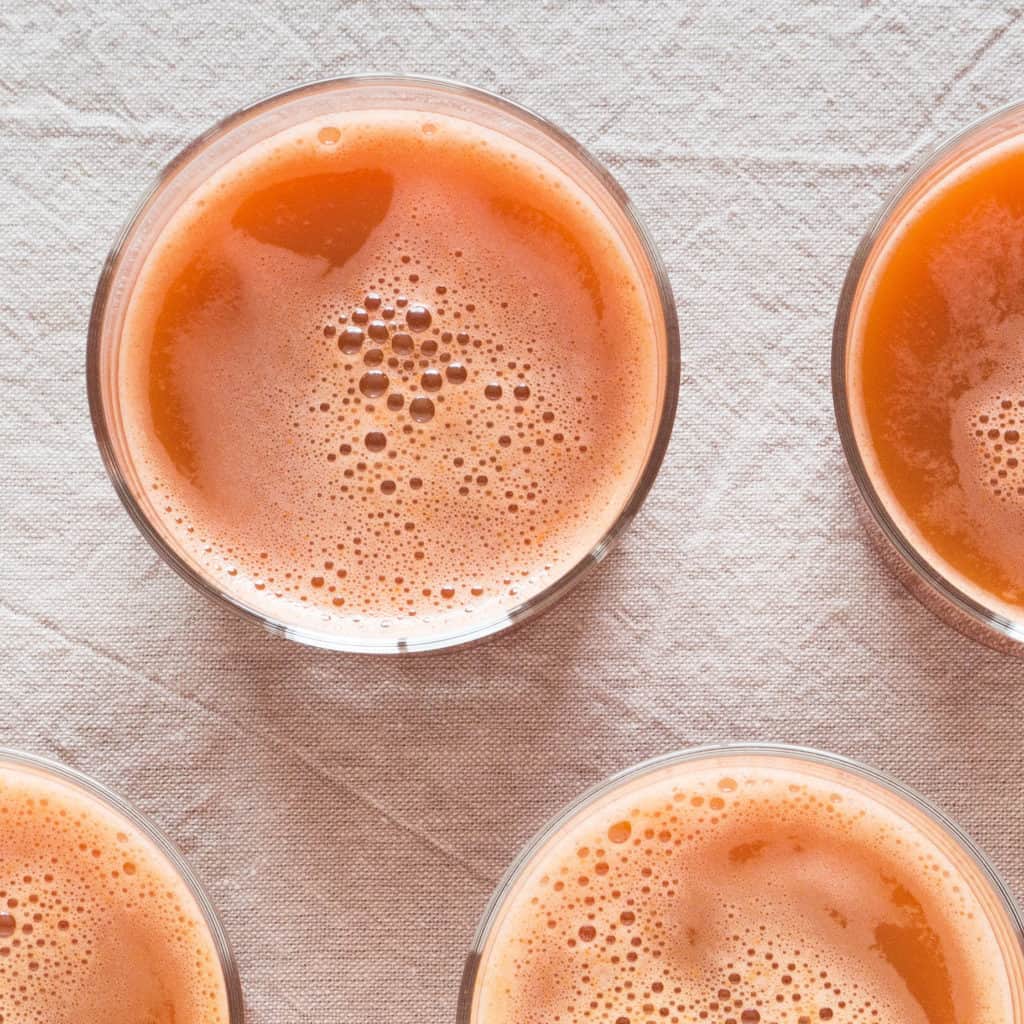
Kitchens are often way too small to store a juicer (mine is!) – and life way too short to clean a juicer. But just because you don’t have a juicer that doesn’t mean you can’t enjoy fresh juice at home!
You can find the full Carrot and Ginger Juice recipe here.
Carrot and Ginger Juice (with nothing else, no sweetener, no apples, nada!) is my second favourite juice (after Beetroot and Carrot Juice. The colour is astounding (it practically glows)! The flavour is incredible! Personally I do not get adding apples to juice (to anything) to make vegetable juice sweet or bulk it out. Apples are way too sweet, too acidic and usually not good for me in general. I REALLY enjoy the flavour (and colour) of the wonderful earthy, vegetables at their best. Unadulterated, full-on, earthy, vegetable flavour.
This will take you all of ten minutes to make and less than half that to clean up. Don’t do what I did the first time I made this and go for volume. I doubled the amount I was going to make, overfilled the food-processor and had beetroot and carrot juice spilling out everywhere… Lesson learned…
Preparation
Difficulty easy
Preparation time 20 minutes
Cooking time 0 minute
You can find the full Carrot and Ginger Juice recipe here.
Allergens
Carrot and Ginger Juice is gluten-free and vegan as well as…
Celery free
Coconut free
Garlic free
Lupin free
Mustard free
Nightshade free
Onion free
Peanut free
Sesame free
Soya free
Tree nut free
About
Carrot is usually teamed with apple in juice. Personally, I detest this combination and detest apple juice in general. It is way too sweet and sickly – and acidic. So I choose ginger – the spiciness of ginger goes so well with the earthiness of the carrots. I also love carrot juice on its own. Nothing else. Both great choices.
Carrots are an interesting vegetable. It is believed that the wild ancestors of the carrot originated in Persia (now Iran and Afghanistan). This area remains the centre of diversity for the wild carrot. A naturally occurring subspecies of the wild carrot was bred selectively over the centuries to reduce bitterness, increase sweetness and minimise the woody core; this process produced the now familiar garden vegetable.
The carrot’s characteristic bright orange colour from β-carotene, and lesser amounts of α-carotene, γ-carotene, lutein and zeaxanthin. α- and β-carotenes are partly metabolized into vitamin A, providing more than 100% of the RDA per 100 gram serving of raw carrots. Carrots are also a good source of vitamin K (13% RDA per 100 grams) and vitamin B6 (11% RDA per 100 grams), but otherwise have modest content of other essential nutrients.
The carrot appears to have been introduced into Spain by the Moors in the 8th century. In the 10th century, in West Asia, India and Europe, the roots were purple. Red and yellow carrots were described in the 11th century. Cultivated carrots appeared in China in the 14th century, and in Japan in the 18th century.Orange-coloured carrots appeared in the Netherlands in the 17th century (the Dutch flag at the time, included orange). European settlers introduced the carrot to colonial America in the 17th century.
Carrots were first cultivated for their aromatic leaves and seeds rather than their roots. Carrot seeds have been found in Switzerland and Southern Germany dating back to 2000–3000 BC. Close relatives of the carrot are still grown for their leaves and seeds: parsley, coriander, fennel, dill and cumin. So, no surprise that carrots naturally pair with those close relatives.
Ginger (zingiber officinale) is a widely available spice today and is used in sweet and savoury cooking and baking across the world. It is thought that ginger originated in southeast Asia and was brought to Europe in the 1st century by traders. Ginger was a popular spice in Rome. Ginger fell from use with the fall of the Roman Empire.
A serving of 100 grams of ground dried ginger provides manganese as a multiple of its RDA. In a typical spice serving amount of five grams, however, ginger powder provides negligible content of essential nutrients, with the exception of manganese present as 79% of RDA. Fresh, root ginger has a high water content (80%) and so raw ginger root has a low overall nutrient per 100 grams.
Ginger is a hot, fragrant spice that can be used fresh, dried, pickled or crystallised. It is the ultimate versatile spice used in sweet and savoury dishes from curries to cakes to stir fries and as condiments. Ginger is pretty amazing.